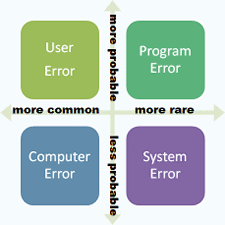3.3 Basic Troubleshooting
Troubleshooting is a logical and systematic search for the source of a problem. Following the steps helps ensure you approach all problems with clear logic, eliminating more common errors before beginning more complex investigations.
A timely diagnosis and a thorough write up of the issues generally leads to a quicker resolution of the problem!
Note: In most cases, you will not be asked to resolve any of these problems by yourself, but knowing about the different types of errors will help with the troubleshooting process.
 Work from Common to Rare Possibilities
Work from Common to Rare Possibilities
Identify and isolate the issue as a first step.
Start with the most probable and common issue, and progress to the least probable and uncommon issue. Consider the chart on the right.
If you have not seen this type of behavior previously, you should move from left to right and then top to bottom when searching for errors (User, Program, Computer, and System).
You may need to troubleshoot several types of errors - user, computer, system, and program errors. Here are some tips for handling the various types of errors.
Instructions: Click on each image below to find out more about different error types:

|

